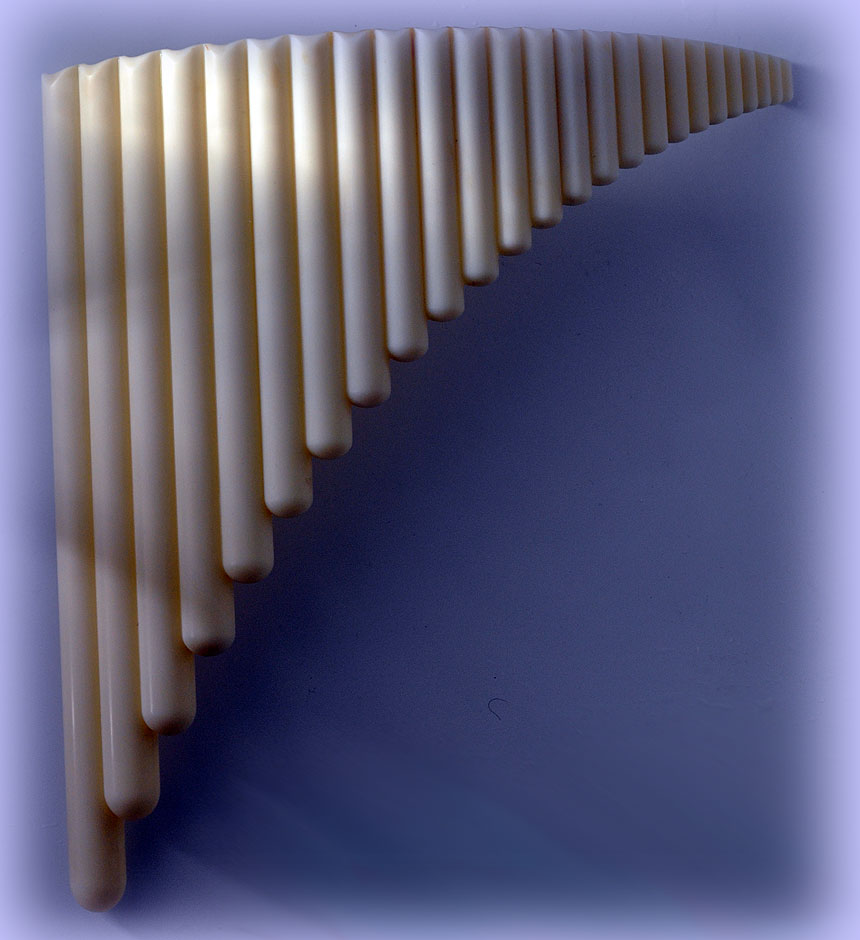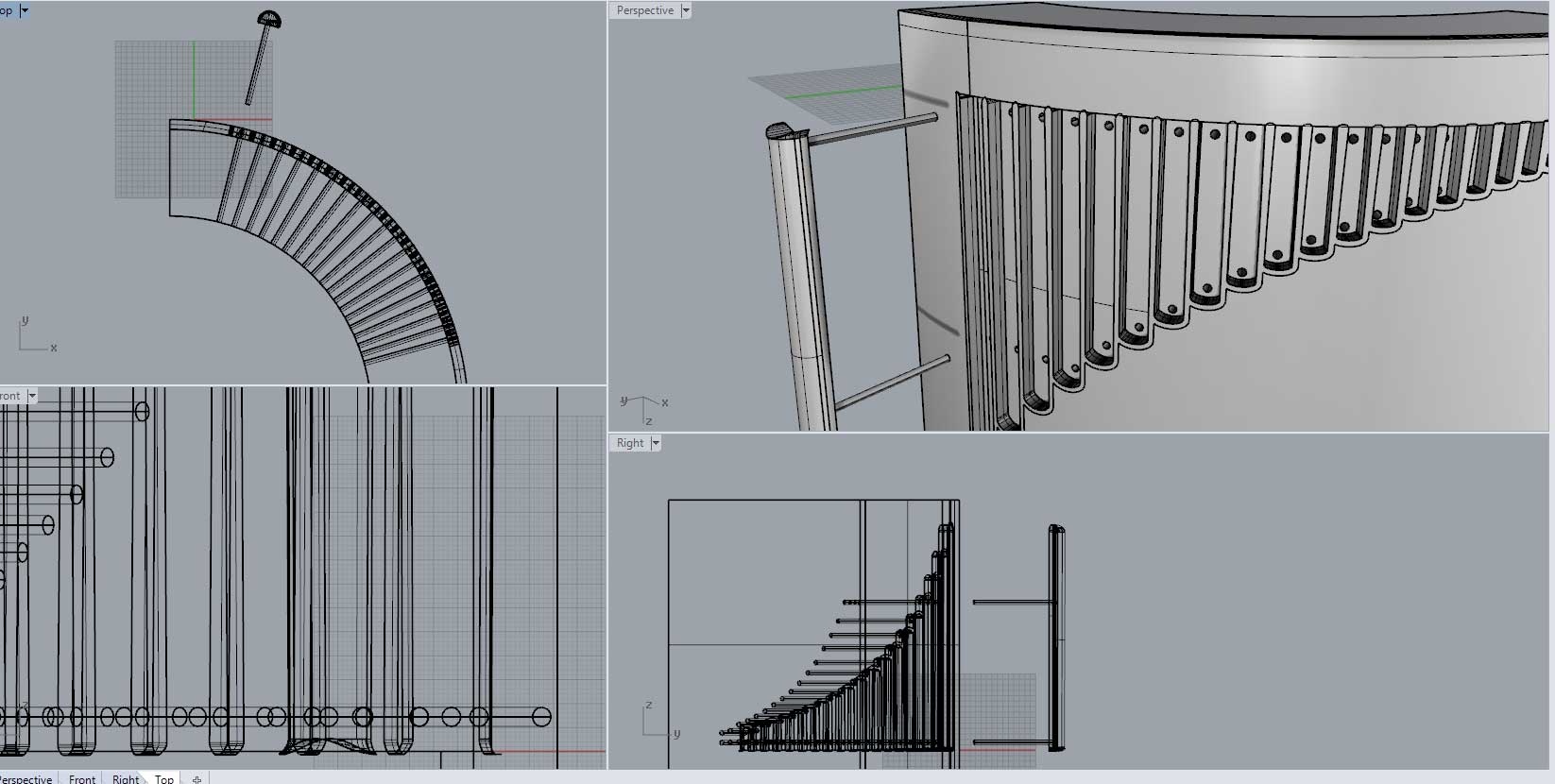News
November 30 2015: Seeing that there is no practical way of molding these flutes without a six-figure investment, and no way of being sure that the uptake will justify that, tuut flutes must bow to the inevitable until an angel comes along. In the meantime I will be offering the same professional quality instruments that I use myself, namely the CNC-machined models which you can check out on our new models page.

November 15 2015: The impossible takes a little longer, and could get expensive! Now working on two molds with 23 inserts each to present every surface at an angle that avoids undercuts. I also contacted Germany's two foremost mold makers, including a two-time winner of best moldmaker award, to see if they wanted to take it on. Here are two sketches of the idea (just one half of one of the molds). Anyone got a spare copy of Cimatron E mold design software, could make this job a whole lot easier!
November 9 2015: Another setback for the new "moldable" option. My supplier suggests molding using their draft angles, and then machining out each tube with a CNC machine. Naturally the cost of each item will skyrocket, without being offset by tooling or assembly economies.
Looks as if we will have to wait for Carbon3d to pull their finger out, something they seem in no hurry to do. They don't even give out information at the moment: weight and size constraints, material safety, let alone when they hope to come to market. From what I saw of CLIP technology at Euromold (or something very similar) it works well with small, easily-drained models - like miniature Eiffel Towers. Draining would obviously be the issue with panpipes, whichever way up you print them.
How Carbon 3d intends to transform the way we make stuff.
November 4 2015: After a lot of exchanges back and forth with China, the original tuutflutes design turns out to be unmoldable in its current form. Rather, you could mold it, but you couldn't get it out of the mold afterwards. Fail! Some moldmakers actually sent me detailed quotes for the work before realizing they couldn't do it at all, and retracting.
This can't be done - too many undercuts:
And this can't be done - too much glueing (they didn't mention the undercuts!):
So I have made a new design using conical bore, open at the bottom, which I will hand-tune with corks using a prototype before ordering a second multi-cavity mold for the stoppers.
Let's hope that using a conical bore will not mean sacrificing too much of the sound qualities afforded by the paraboloidal bore and round bottoms that make the original design so powerful and easy to play. It looks like those will have to go on being made by CNC, costing anything up $1000 for the four-octave model.
So my dream of offering a top professional model for the price of a school recorder is still some way off!
As for the new moldable design, it's not even sure that the engineers will accept my draft angles. What they want is tapers that make it easy to pull the flute out of the mold. What I want is tapers that get the partials in tune, for ease of play and fullness of sound. Let's see if East can meet West on this issue!
September 26 2015: Just got back from Euromold 2015 in Duesseldorf, Germany, having talked to over a dozen, mostly Chinese, companies about injection-moulding the alto 19-tube 3-octave model, in right-handed format. It was good to meet the engineers face-to-face, both to learn about the business, and to suss out their competence and attitude to my project.
The good news is that the mould can be done in just two cavities, followed by ultrasonic welding, something I had never heard of. So things are looking good for a Kickstarter project offering the flutes for under $30 each - provided we get 3000 takers! Watch this space, and then share like crazy!!
September 3rd 2015: Getting ready for my trip to Düsseldorf, Germany for the Euromold 2015 trade fair, to see if some moulding solution can be found to bring these serious panpipes to every kid who wants one, at a price his mom can afford.
The thing is, with the reverse conicity of the tubes it may not even be possible to injection-mould them in one piece, and silicon moulding offers limited production runs. So I'll be looking for signs of progress on that front.
And if I find the right partner, look out for my next Kickstarter project and subscribe to get your own tuut flute!
And meanwhile, if you want to help me get to Düsseldorf, you can help fund me on Gofundme.
If all else fails, I am looking forward to the rollout of CLIP technology by Carbon3D some time next year. Their video is well worth checking out. With eight models of tuutflutes (when you count left and right handed versions) moulding may not be the best option at all.
August 31st 2015: Though I'm not a great fan of brands, and generally avoid branded foods and clothes wherever possible, it may one day be necessary to brand tuut flutes, if only to guarantee the conformity of the design.
Since my designs have been downloaded over 3000 times, who is to say what production shortcuts and inappropriate materials have been used? In particular the difficulty of moulding the paraboloid bore might tempt manufacturers to cut corners.
I am happy that so many people find the idea of wholetone tuned serious panpipes useful, but one day buyers might need to know they have an instrument made according to the original specs in safe, durable materials, with the best possible finish and tuning.
The symmetrical tuut logo can be applied to left-handed and right-handed models, and placed usefully where they can help the player find her note at a glance.
Materials
 The acoustics of wind instruments depends virtually entirely on the shape of the air cavity and the playing edges. Provided the wall material can be worked to a suitable finish and is thick enough to resist mechanical dissipation of the acoustic energy, it makes no contribution to the sound.
The acoustics of wind instruments depends virtually entirely on the shape of the air cavity and the playing edges. Provided the wall material can be worked to a suitable finish and is thick enough to resist mechanical dissipation of the acoustic energy, it makes no contribution to the sound.
Until a suitable production process can be found, Tuut flutes panflutes are individually machined from solid blocks of ABS plastic by the CNC process, using a 3D design made on a computer.
Exact diameters, lengths and mouthpiece geometry were perfected with a succession of prototypes before settling on the final model(s). The internal conicity of the tubes could also be precisely regulated, and graduated throughout the instrument's range, for a homogeneous sound and response.
Less fatigue
With plastic, tubes can be placed closer together than with wood or bamboo without fear of splitting the material. The instrument needs no shoe (the wooden part running along the bottom) and therefore weighs about 30% less than a traditional flute of the same range, while wholetone tuning cuts the weight by a further 14% as there are only six tubes per octave insted of seven.
This all reduces player's neck fatigue and allows a more legato style of playing. And of course, plastic panpipes are dishwasher safe!
aerodynamic mouthpiece
The greatest advantage of plastic is that it can be formed to any shape and any diameter using 3D computer modelling, without the limitations of woodworking tools.
Tuut flutes mouthpieces are not simply bevelled around the edges, but have a carefully designed aerodynamic shape to give fast response and rich tone.
The tubes become gradually narrower near the open end to bring the harmonics in tune with the fundamental, using a "paraboloid" tube profile suggested by Denis Klimov (who also contributed the Russian translation of this site).
The specially developed mouthpiece design takes advantage of the freedom offered by the material. The wide blowing edge and lateral beveling on each tube eliminate dead spots between tubes, enabling singing legato.
Finally the edge nearest the player offers a comfortable cushion for the lips, making it easy to obtain the semitones and eliminating abrasion of the skin.
You can choose other materials by going to my Shapeways shop.
Follow me on Twitter @jazzpanflute




















